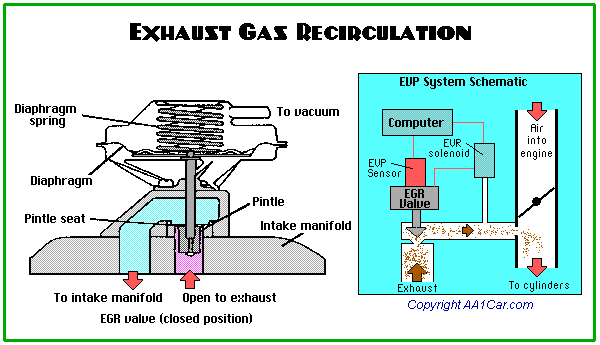How EGR works

Back in the 1970s, when the car manufacturers were first required to start reducing engine pollution, a new technology called Exhaust Gas Recirculation (EGR) was developed. EGR is a technique to reduce combustion-related air pollution, primarily nitrous oxides (NOx).
About NOx
Nitrous oxides are molecules combining nitrogen and oxygen. They are generally noted by their chemical name NOx (NO, NO2,NO3, etc.) Nitrous oxides are bad for humans because they are considered irritant gasses that cause inflammation of airways when inhaled. Nitrous oxides also are a main ingredient of smog as well as being a central component of acid rain.
How EGR works
It was discovered that short, high temperature, combustion temperatures create an abundance of NOx. However, engineers discovered that by blending an inert gas with the air/fuel mixture, that they can slow down the rate of combustion and the high temperatures in the combustion chamber. This, in turn, reduces the NOx components.
The EGR system is designed to recirculate the exhaust gas into the air/fuel mixture, thereby diluting the mixture enough to keep the NOx compounds under control. This is done by allowing a small amount of inert gas to pass from the exhaust manifold into the intake manifold through the EGR valve.
Early EGR systems
The service techs at Fort Dodge Ford in Fort Dodge, IA, a full service Ford, Lincoln, Toyota dealer, explained that the early EGR systems were made up of a vacuum-operated EGR valves that admits exhaust gas into the intake manifold. The system was simple, a vacuum hose that is connected to a carburator port above the throttle plate and a thermostatic vacuum switch (TVS) controlled the EGR valve.
At idle, the throttle plate blocks the vacuum port so no vacuum reaches the EGR valve and it remains closed. As you accelerate, the throttle uncovers the port in the carburator or the throttle body, the vacuum signal reaches the EGR valve and slowly opens it, allowing exhaust gases to enter into the intake manifold.
Since the exhaust gas causes a rough idle and stalling when the engine is cold, the TVS only allows vacuum to the EGR valve when the engine is at normal operating temperature. Also, under acceleration, there is very little vacuum available, resulting in very little exhaust gas injection that would interfere with power output.
Modern EGR
The EGR valve on engines with electronic fuel injection systems is controlled by the engine control computer (ECM). EGR valves on computerized vehicles normally have computer-controlled solenoids in line between the valve and the vacuum source. They also often have an EGR position sensor that informs the computer what position the EGR valve is in. Because NOx limits are very stringent today, modern engines are also equipped with oxidation/reduction catalysts and special fuel injection systems that keep the NOx compounds under control. But even with these newer, more efficient systems, the EGR system is still necessary to reduce the excess emissions. They will be on internal combustion engines for many years to come.
Photo credit : aa1car.com





